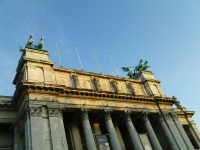Art museum
From The Art and Popular Culture Encyclopedia
_by_Giovanni_Paolo_Panini.jpg)
|
"M. Viardot has had the advantage of visiting all the great picture galleries of Europe, and writing his criticisms with the paintings before his eyes."--A Brief History of the Painters of All Schools (1877) by various authors "AMONG the most pathetic figures in the world must be counted the men and women who may be seen in any picture-gallery slowly circumambulating the four walls with eyes fixed upon the catalogue or guide-book only looking up at intervals to insure that they are standing before the right picture." --How to Look at Pictures (1902) by Robert Witt |
|
Related e |
|
Featured: |
An art gallery or art museum is a space for the exhibition of art, usually visual art. Museum can be public or private but what distinguishes a Museum is the ownership of a collection. Paintings are the most commonly displayed art objects; however, sculpture, photographs, illustrations, installation art and objects from the applied arts may also be shown. Although primarily concerned with providing a space to show works of visual art, art galleries are sometimes used to host other artistic activities, such as music concerts or poetry readings.
Contents |
Types of galleries
The term is used for both public galleries, which are museums for the display of selected collection of art. On the other hand private galleries refers to the commercial enterprises for the sale of art. However, both types of gallery may host traveling exhibits or temporary exhibitions including art borrowed from elsewhere.
Galleries in museums
The rooms in museums where art is displayed for the public are often referred to as galleries as well, with a room dedicated to Ancient Egyptian art often being called the Egypt Gallery, for example.
Contemporary art gallery
The term contemporary art gallery refers usually to a privately owned for-profit commercial gallery. These galleries are often found clustered together in large urban centers. The Chelsea district of New York City, for example, is widely considered to be the center of the contemporary art world. Smaller cities are usually home to at least one gallery, but they may also be found in towns or villages, and remote areas where artists congregate, e.g. the Taos art colony and St Ives, Cornwall.
Contemporary art galleries are usually open to the general public without charge; however, some are semi-private. They usually profit by taking a cut of the art's sales; from 25 to 50% is usual. There are also many not-for-profit and art-collective galleries. Some galleries in cities like Tokyo charge the artists a flat rate per day, though this is considered distasteful in some international art markets. Galleries often hang solo shows. Curators often create group shows that say something about a certain theme, trend in art, or group of associated artists. Galleries sometimes choose to represent artists exclusively, giving them the opportunity to show regularly.
A gallery's definition can also include the artist run centre, which often (in North America and Western Europe) operates as a space with a more democratic selection and mentality. An artist-run space also typically has a board of directors and a support staff that select and curate shows by committee, or some kind of similar process to choose art that typically lacks commercial ends.
Vanity galleries
A vanity gallery is an art gallery that charges fees from artists in order to show their work, much like a vanity press does for authors. The shows are not legitimately curated and will frequently or usually include as many artists as possible. Most art professionals are able to identify them on an artist's resume.
Visual art not shown in a gallery
Works on paper, such as drawings and old master prints are usually not chosen by curators to be permanently displayed for conservation reasons. Instead, any collection is held in a print room in the museum. Murals generally remain where they have been painted, although many have been removed to galleries. Various forms of 20th century art, such as land art and performance art, also usually exist outside a gallery. Photographic records of these kinds of art are often shown in galleries, however. Most museum and large art galleries own more works than they have room to display. The rest are held in reserve collections, on or off-site.
Similar to an art gallery is the sculpture garden (or sculpture park), which presents sculpture in an outdoor space. Sculpture installation has grown in popularity, whereby temporary sculptures are installed in open spaces during events like festivals.
Architecture
The architectural form of the art gallery was established by Sir John Soane with his design for the Dulwich Picture Gallery in 1817. This established the gallery as a series of interconnected rooms with largely uninterrupted wall spaces for hanging pictures and indirect lighting from skylights or roof lanterns.
The late 19th century saw a boom in the building of public art galleries in Europe and America, becoming an essential cultural feature of larger cities. More art galleries rose up alongside museums and public libraries as part of the municipal drive for literacy and public education.
In the middle and late 20th century earlier architecural styles employed for art museums (such as the Beaux-Arts style of the Metropolitan Museum of Art in New York City or the Gothic and Renaissance Revival architecture of Amsterdam's Rijksmuseum) were increasingly replaced with more modern styles, such as Deconstructivism. Examples of this trend include the Guggenheim Museum in New York City by Frank Lloyd Wright, Frank Gehry's Guggenheim Museum Bilbao and Mario Botta's redesign of the San Francisco Museum of Modern Art. Some critics argue that these galleries are self-defeating, in that their dramatic interior spaces distract the eye from the paintings they are supposed to exhibit.
See also
- List of art museums
- Art exhibition
- Artist-run initiative
- Artist-run space
- Arts centre
- Contemporary art gallery
- List of notable museums and galleries
- National gallery
- Vanity gallery


